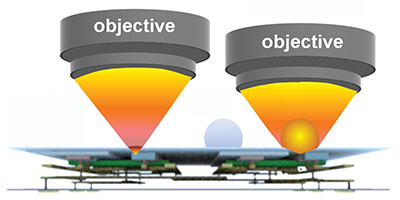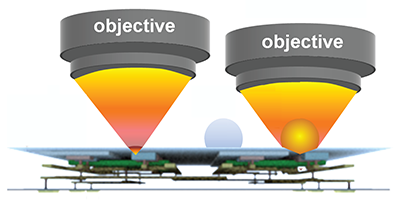Zooming in on Failures
As integrated circuits are increasingly miniaturized, it becomes crucial to develop nondestructive ways to detect the presence of defects with sufficient spatial resolution. According to semiconductor industry requirements, a resolution of 100 nanometers (nm) is necessary for characterizing state-of-the-art flash memories and next-generation circuits. A number of theoretical studies indicated that “super-resolution” microscopy techniques could be used to localize defects with the required resolution and in a noninvasive way. Now, a team of researchers led by Xudong Chen at the National University of Singapore has used a near-infrared microscope to experimentally resolve 100-nm features buried in integrated silicon circuits.
Localizing defects within a silicon substrate requires using near-infrared light because silicon is opaque to optical and ultraviolet radiation. However, the Rayleigh resolution limit of near-infrared light is several times too large to detect 100-nm features. Chen and his team overcame this limitation by illuminating the defects using near-infrared light shone through a spherical silicon lens. The lens, placed flush against the substrate, enabled near-field image acquisition with a resolution increased by roughly the refractive index of silicon ( ∼3.4). The light reflected by the sample was collected by a photodetector after passing through a pinhole, whose size was optimized to prevent certain distortions of the image collected by the detector. Chen and his collaborators suggest that the resolving power of their microscope can be augmented with other types of filters to yield even higher resolutions: A resolution of 75 nm will be necessary for industrial needs by 2026, according to predictions.
This research is published in Physical Review X.
–Katherine Kornei





